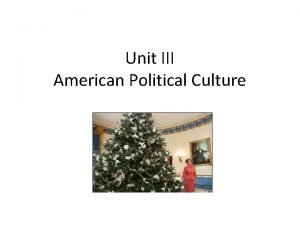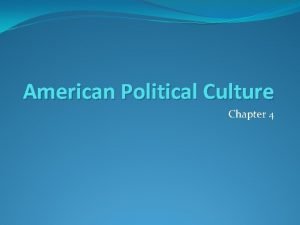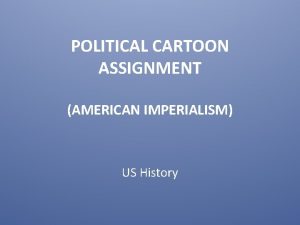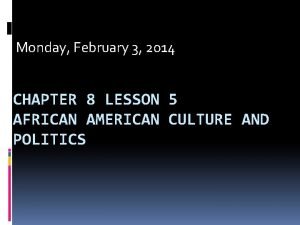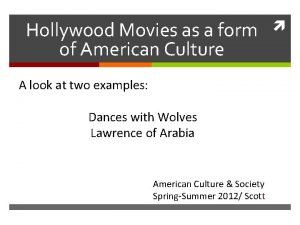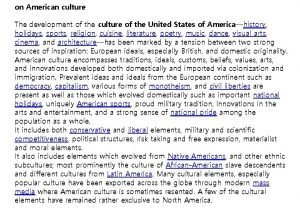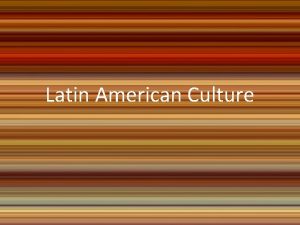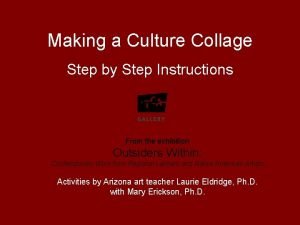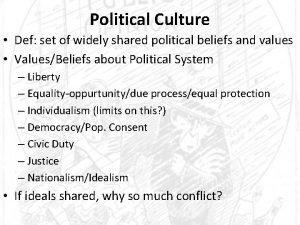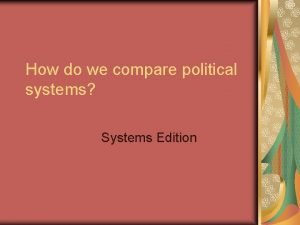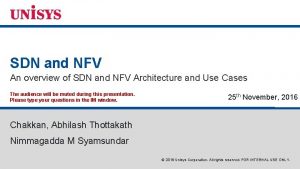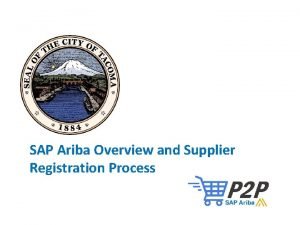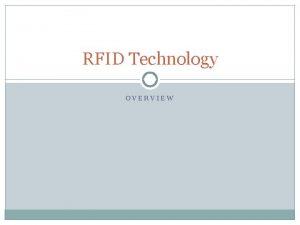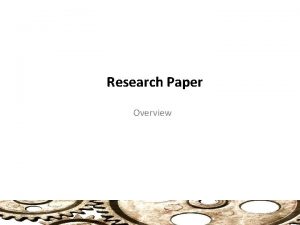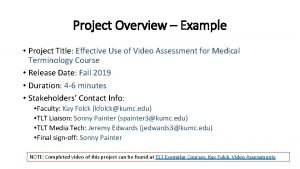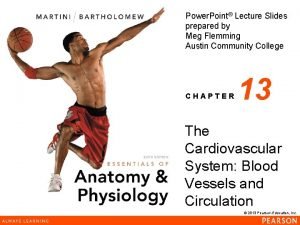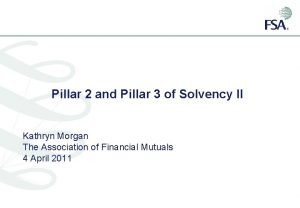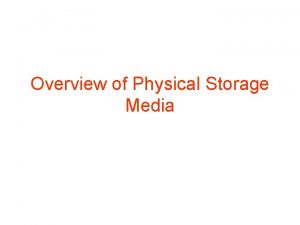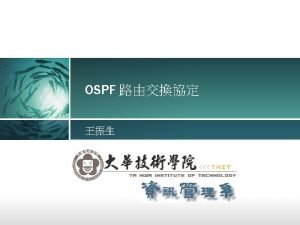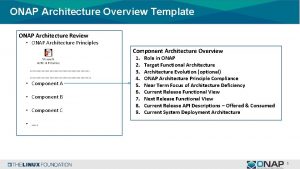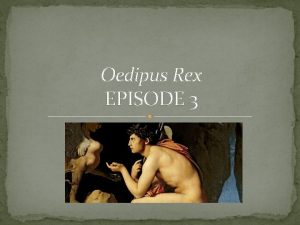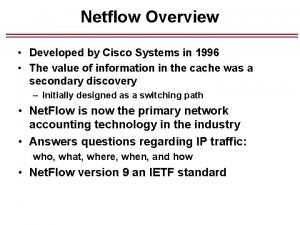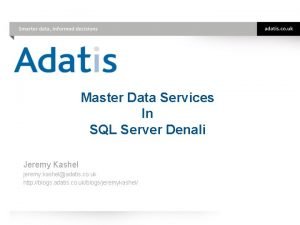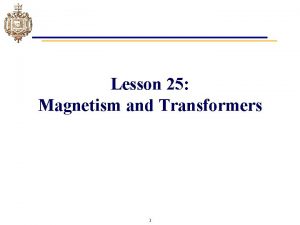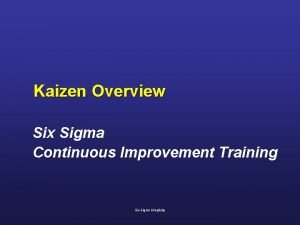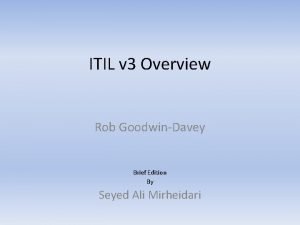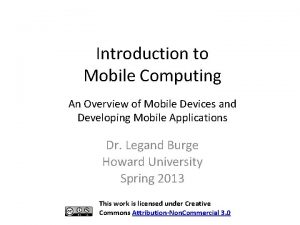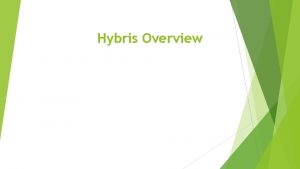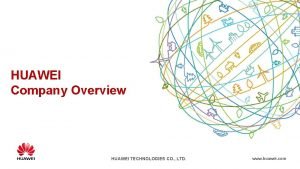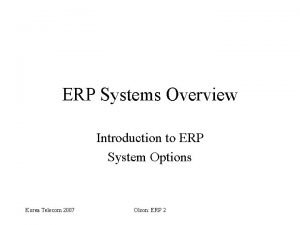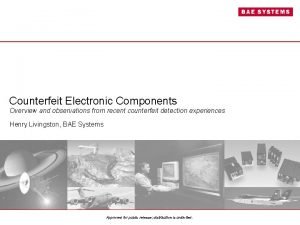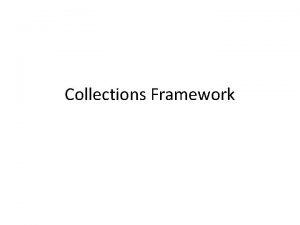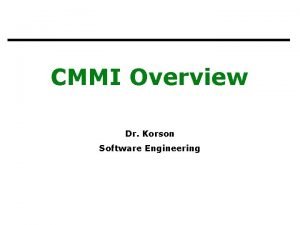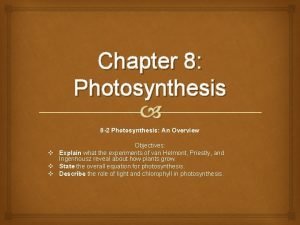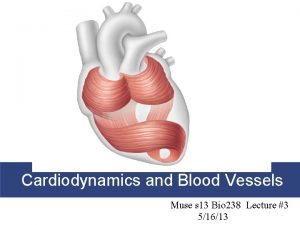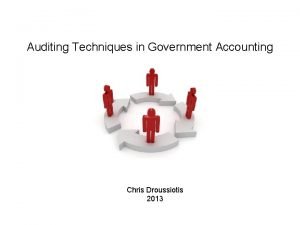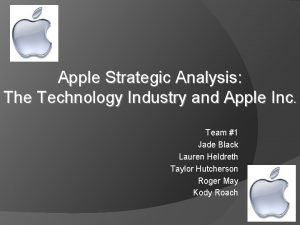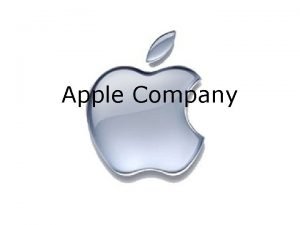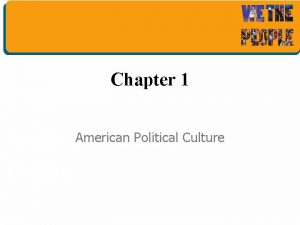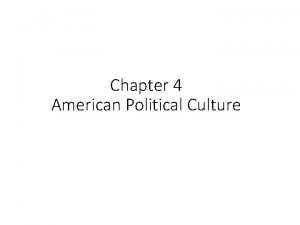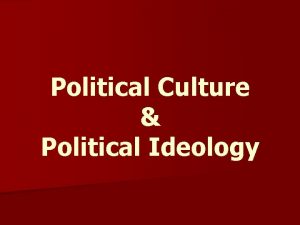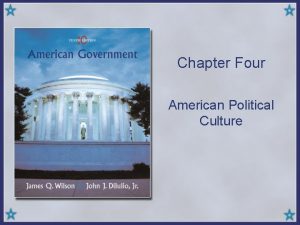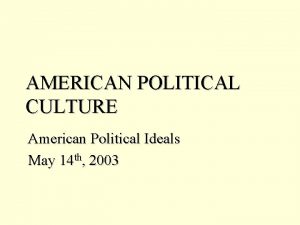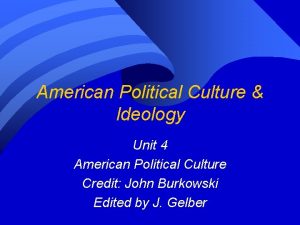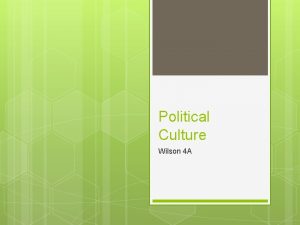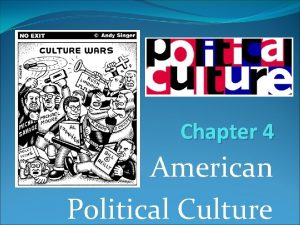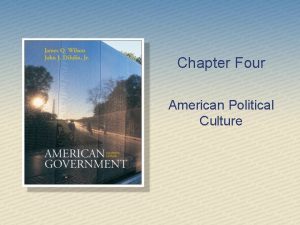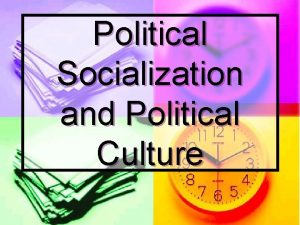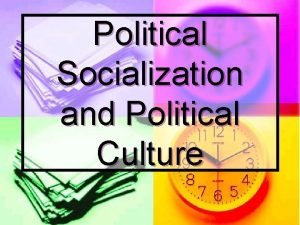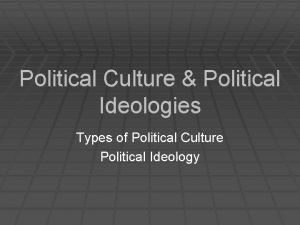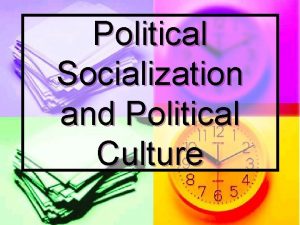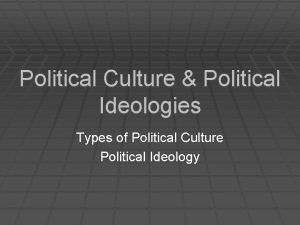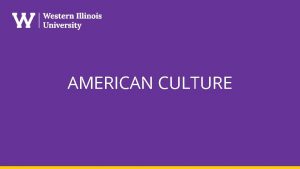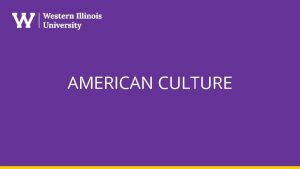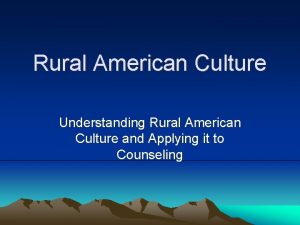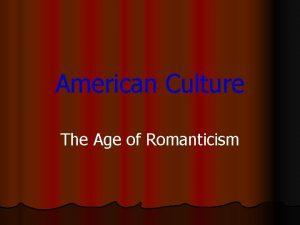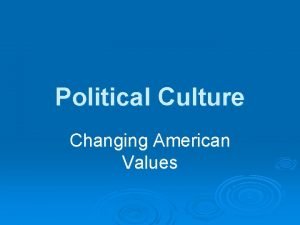American Political Culture An Overview Political Culture Political








































































































- Slides: 104

American Political Culture: An Overview

Political Culture • Political Culture – A coherent way of thinking about how politics and government ought to be carried out – The broad pattern of ideas, beliefs, and values about citizens and government held by a population • Political Socialization – The process through which individuals acquire their political beliefs and values

Sources of Political Culture • Historical Roots – American Revolution – fought over liberty – Constitution – balancing liberty with control – Long standing distrust of authority • Sociological Factors – – Widespread participation Absence of established religion made diversity possible Family: instills ways we think about world and politics Lack of class consciousness (a belief that you are a member of an economic group whose interests are opposed to people in other such groups) • Most people consider themselves middle class • The American Dream?

Sources of Political Culture • Culture Wars – Battle over values; different from political disputes in 3 ways • Money not at stake • Compromises almost impossible • Conflict more profound – Differences in beliefs about private and public morality • Orthodox – morality is more important than self expression • Progressive – personal freedom more important than tradition; rules change based on circumstances

What we believe: The ideas that unite us • Values: central ideas, principles, or standards that most people agree are important; elements of the American view of the political system include: • • • Democracy – government officials should be accountable Equality – equal vote and equal chance to succeed Liberty – free to do what we want with limited expectations Civic Duty – people should help and take things seriously Individual Responsibility – responsible for your own actions and well being

Questions Directions: Answer the following discussion questions with your partner. 1. How do we know Americans share these values? 2. If these values are important, how can we explain inconsistent behavior? 3. If there is agreement among Americans on certain political values, then why so much political conflict? 4. What does Americanism mean?

Questions Directions: Answer the following discussion questions with your partner. 1. How do we know Americans share these values? – Books, speeches, slogans, political choices, personality tests, opinion polls 2. If these values are important, how can we explain inconsistent behavior? – – Self interest and social circumstances Myrdal described “an American dilemma” resulting from conflict between creed and behavior (Creed is a source of change)

Questions Directions: Answer the following discussion questions with your partner. 3. If there is agreement among Americans on certain political values, then why so much political conflict? – – Conflict over specific policies (even among those who have common beliefs) Civil War – Confederate Constitution modeled after US; the South didn’t believe a new political culture had to be created 4. What does Americanism mean? – Bound by common values and hopes

Faith in rules and individuals • Most Americans believe we should focus on fair rules and processes rather than guaranteeing results, and on individuals being responsible for their own success. – Procedural guarantees: government assurance that the rules will work smoothly and treat everyone fairly, with no promise of particular outcomes – Other democracies, such as those in Sweden and Norway, concentrate on substantive guarantees: assuring outcomes are fair. • Equality of opportunity vs. equality of results

Faith in rules and individuals • Individualism: belief that what is good for society is based on what is good for individuals – Individuals, not government, are responsible for their own wellbeing – Politics revolves around the belief that individuals are usually the best judges of what is good for them – We assume that what is good for society will follow automatically. • Collectivist point of view: gives the government some responsibility for individual welfare and holds that what is good for society may not be the same as what is in the interest of individuals.

Political Efficacy • Definition -- citizen’s capacity to understand influence political events; 2 parts: 1. Internal efficacy -- confidence in one’s ability to understand influence events • Hasn’t changed much in past 60 years 2. External efficacy -- belief that govt. will respond to citizens • Declined steadily in past 60 years • Americans seem to believe govt. is becoming too big to respond to individual preferences • Still much higher in U. S. than Europe – We’re not alienated, but realistic

Political Tolerance • Allows free discussion of ideas and selection of rulers • Levels of Tolerance: – Most Americans agree abstractly, but would deny rights in concrete cases – Many fear U. S. is too tolerant of harmful behaviors, so we sometimes defend common “moral standards” over protecting individual rights – Still, most willing to allow expression by those we disagree with • How do unpopular groups survive? – Most people don’t act on their beliefs – Officeholders more tolerant than general public – Courts are insulated enough from public opinion to enforce constitutional protections

Almond-Verba Study • Americans have a strong sense of: – Civic duty – belief that one has obligation to participate in civic and affairs – Civic competence – a belief that one affect govt. policies • Americans vote less often than other countries, but our citizens campaign more, attend more political meetings, contact govt. officials more • We’ve lost some trust in govt. , but still higher than most countries • Slight majority says they’re “very patriotic”

Factors of Political Socialization • Family - #1 factor – Children tend to choose the same party as their parents • Schools and education – Citizenship skills • Groups – The spiral of silence: the process by which a majority opinion becomes exaggerated because minorities do not feel comfortable speaking out in opposition • Political and social events – Examples of divisive and unifying events?

Political Culture – Sources of Division • Self-interest • Gender – Gender gap – Marriage gap • Partisanship • Religion • • Race & Ethnicity Geographic Region Economic Status Age – Political generations • Education

Public Opinion – Sources of Division • Self interest – What is in it for me? • Ideology – sets of ideas about politics, the economy, and society • Education – better educated=more likely to vote • Age – Political generations: groups of citizens whose political views have been shaped by the common events of their youth • Geography – region and metropolitan status • Economic status – what do the extremes have in common? • Religion – Protestant/Catholic vs. Jewish/None

Gender Examples • More men support military • More women consider sexual harassment a serious problem • Since ’ 60 s, women vote Dem more than men, and vice versa • Not as significant of an indicator as marriage (married vs. unmarried)

Religion Example • Protestants are more conservative on economic matters than Catholics or Jews • Jews tend to be liberal on economic and social issues than Catholics or Protestants • Catholics tend to be more liberal on economic issues than they are on social issues (Catholics becoming more conservative)

Education Example • Higher Education = more conservative or • College education = liberal views Conflicting results, not always a correlation

Social Class • “Blue collar” (Laborer) typically Democrat • “White collar” (Businessmen) typically Republican Relationship is becoming less clear

Race and Ethnicity Examples • African Americans – 90% Democrats • Hispanic Americans – tend to affiliate with Democrats, but less likely than African Americans • Asian Americans – less liberal than Hispanic Americans or African Americans, but still consistently vote Democrat • White, more divided, fluctuates by election

Geographic Region Example • East and West Coasts – more liberal • Mid-West – more conservative • Urban - liberal • South – 1870 -1950 s - Democrat “Solid South” but today they are primarily social conservatives • White Southerner usually less liberal


Mistrust of Government • Increasing since 1950, but ebbs and flows – Causes: Vietnam, Watergate, Clinton impeachment – High patriotism after 9/11 • Support for the President most likely to fluctuate • No dramatic change in confidence of Americans themselves or in system as a whole – What institutions have the highest approval?

Do Men and Women Think Differently about Political Issues? Political Issue Men Agreeing (%) Women Agreeing (%) Labor unions are necessary to protect the working person. 59 68 The best way to ensure peace is through military strength. 57 50 Women get fewer opportunities than men for good jobs. 45 52 Is global climate change a problem? 66 83 Do you support same-sex marriage? 52 58 Source: Pew Research Center.

What Is the Extent of Americans’ Political Knowledge? Can You Identify the Following? Percentage Answering Correctly Photo of Martin Luther King Jr. 91 Majority party in the Senate 52 Pope Francis is from what country? (Argentina) 52 Photo of Senator Elizabeth Warren 51 Number of women on Supreme Court 33 Source: Nick Glass “Americans Bomb Pew Test of Basic Political Knowledge, ” Politico, 4/28/15.








What we believe: The ideas that divide us • Ideologies: – sets of beliefs about politics and society that help people make sense of their world – Coherent set of values and beliefs about public policy – Changes over time for people; terms have meant different things at different time periods – A political spectrum is a system of classifying different political positions upon one or more geometric axes that symbolize independent political dimensions – Crash Course in Political Ideology

What we believe: The ideas that divide us • Conservative vs. Liberal? – Conservatives: people who generally favor limited government and are cautious about change – Liberals: people who generally favor government action and view change as progress


Political Ideology Chart

Ideological dimensions • The economic dimension – Conservatives prefer little government involvement in economy – Liberals see a positive government role • The social order dimension – Economic security has led Americans to become more concerned with quality-of-life and moral issues – Division over limited versus more active government control of individual lives


Our Economic System • We say our economy is “fair and efficient” • But, we believe in limits to market freedom – Govt. should regulate business to prevent monopolies, correct specific abuses • We tolerate economic inequality more than political inequality – Equality of opportunity OK, but not equality of results – Liberal groups more willing to view disadvantages women and minorities have faced to be result of failures of econ. System rather than fault of individuals – We’re willing to help people “truly in need, ” but not those who can help themselves – Ethic of self-reliance, personal responsibility, individualism

Our Economic System • Free enterprise – individuals and businesses allowed to compete for profit with minimal govt. interference (“laissez-faire”) • Capitalism – private citizens own most (if not all) of the means of production, and decide how to use them • Market Economy – individuals own the factors of production, make economic decisions through free interaction

Relationship between the ideological dimensions • The two dimensions do not dovetail neatly • Leaves different mixes of ideological groups – – – Economic liberals Social liberals Economic conservatives Social conservatives Libertarians Communitarians

Economic System

Voting, Campaigns, and Elections: An Overview

10 Steps to the American Presidency • Step 1 - Invisible Primary/Announcement • Steps 2/3/4 – Caucus & Primary, Primary Debates, Primary Campaigning • Step 5 – General Election Campaign Begins • Step 6 – Vice Presidential Choice • Step 7 – Convention • Step 8 – General Election Debates • Step 9 – Election Day • Step 10 – Transition/Inauguration

Step 1 - Announcement • Invisible Primary – Raise money (PACs) – Raise credibility, improve reputation • Announcement – Previous Elections • President Obama announces 2008 • Mitt Romney announces 2012 (video) – 2016 Election • Hillary Clinton (2016) • Donald Trump (2016)

Steps 2/3/4 – Primary/Caucus • Primaries and caucuses – Presidential primary: an election by which voters choose convention delegates committed to voting for a certain candidate • Open Primary – primary elections in which eligible voters do not need to be registered party members • Closed Primary – primary elections in which only registered party members may vote – Party caucus: local gathering of party members to choose convention delegates


Steps 2/3/4 – Primary/Caucus • Primaries and caucuses, cont’d. – Front-loading: the process of scheduling presidential primaries early in the primary season – Front-runner: the leading candidate and expected winner of a nomination or election – Momentum: the widely help public perspective that a candidate has gained electoral strength

Step 2/3/4 – Primary/Caucus • Primary Campaigning – 2008 Democratic Primary: Clinton 3 am ad vs. Obama 3 am ad • Primary Debates (highlights) – Democratic First Primary Debate, 2015 – Republican First Primary Debate, 2015


Republican Primary - 2016

Step 5 – General Election • The 3 M’s – Media – Money – Moving to the “middle”

Step 5 – General Election • Valence issue: an issue on which most voters and candidates share the same position • Position issue: an issue on which the parties differ in their perspectives and proposed solutions • Wedge issue: a controversial issue that one party uses to split the voters in the other party • Issue ownership: the tendency of one party to be seen as more competent in a specific policy area

Step 5: General Election (Media) • Campaign Advertisements – What is the difference between negative, positive, contrast and inoculation advertisements? Can you think of any examples? • Favorable airtime on news • Candidates appear on soft news or entertainment programs • Debate performance is important because many people watch and they have significant effect on voters

Step 5 – General Election (Media) • www. livingroomcandidate. org o o o 1952 – I Like Ike 1964 – Daisy Ad 1988 – Willie Horton Ad 2008 – Celebrity Ad 2012 – 47%; Give Me a Break 2016 Election o Hillary Clinton – Mirrors, Daisy o Donald Trump – Deplorables, Predators

Step 5 – General Election (Money) • Where does the money come from: – A brief overview… – US Elections: Where Does The Money Come From (BBC Resource) – Political Campaigns: Crash Course

Step 5 – General Election (Money) • Sources of Campaign Funding – Individuals – Political Parties – Personal Savings – PACS and 527 s – 501 (C) Groups – Super PACS – Public Funds

Public funding: Government matching funds • What are the rules for this source of funding? • Why do candidates like Barack Obama choose to opt out?

Figure 12. 5 How Do PACs Allocate Their Campaign Contributions? Source: Data from the Center for Responsive Politics, www. opensecrets. org/pacs/, 2016.

Private funding: Hard money • Who gives hard money? • What candidates do with it?

Private funding: Soft money • How does this differ from hard money? • What can’t groups do with it? • Issue advocacy ad – advertisement paid for by soft money (and thus not regulated) that promotes a certain issue position but does not endorse a specific candidate • Sometimes the lines get a little murky…

Citizens United v. FEC (2010) • Limiting corporations’ election spending and telecommunications violates First Amendment rights • Political speech is essential to a healthy democracy. It doesn’t matter if this communication comes from a corporation. • A transformative decision?

Mc. Cutcheon v. FEC • 2014 Supreme Court Ruling • Declared part of the Federal Election Campaign Act (FECA) unconstitutional – Unconstitutional: The section imposed limits on any individual’s total political contributions (to federal candidates, parties, or political action committees) in a two year cycle – $2, 700 per individual

Figure 12. 6 How Has Campaign Financing Changed Over Time? Source: Data from the Center of Responsive Politics.

Step 5: General Election Trends and interpretations of campaigns • Get-out-the-vote (GOTV) drives by parties and groups – Grassroots efforts that have increased in recent elections • Interpreting elections – Winner claims that victory provides a policy mandate – Media develop common story explaining outcome – example: Explanation of Obama re-election

Step 6 – VP Choice Step 7 - Convention • Question: What factors go into choosing a running mate? – Clinton announces Kaine (40: 00) – Trump announces Pence (19: 00) • Question: What is the purpose of a national convention? – 2016 DNC Highlights – 2016 RNC Highlights

Step 8 – Gen Election Debates • Great Moments – Presidential Debates – Vice Presidential Debates • 2016 Debates (and VP debate highlights) • Impact of Pop Culture

Step 9 – Voting and Elections • The Constitution reflects the founders’ fears of citizens’ judgment about politics – Senators were not directly elected – The president was not directly elected (Electoral College) – Only members of the House of Representatives were directly elected (Popular Vote) • Functions of Elections – Select leaders, Direct policy, Citizen development, Inform the public, Contain conflict and Legitimacy and system stability

Step 9 – Voting History • Lifting property restrictions (1830) – “universal white male suffrage” • Suffrage for African Americans – – 15 th Amendment Civil Rights Act of 1964 Voting Rights Act of 65 24 th Amendment • Voting Amendments – 15, 17, 19, 23, 24, 26


Step 9 – Election Day/Voting • Electoral College – “Winner-take-all” System which chooses the president and vice president • How the Electoral College works • The Trouble with the Electoral College • Election Results – www. 270 towin. com


Figure 12. 1 How Is Voting Power Apportioned in the Electoral College? Source: CNN, http: //www. cnn. com/election/2012/results/race/president.

Voting in America: who votes and who doesn’t • Cross-cutting cleavages – individuals influenced by many factors – Age: younger Americans (18 -24) vote less frequently, although younger Americans are starting to vote more – Income: poorer Americans vote less frequently – Education: Americans with less education vote less frequently – Race and ethnicity: minorities vote less frequently (might be economic-based) – Religious involvement – Gender – men traditionally voted more, now it is more equal – Two-party competition: more competitive elections have higher turnout

Voter Turnout • Registered Voter turnout • Eligible Voter turnout • Voter Registration – blamed as one of the causes of low turnout – “Motor-Voter” (1993) – National Voter Registration Act – allowed people to register to vote while they get license

Table 12. 3 How Do States Regulate Voter Eligibility? Requirements for Voter Eligibility In How Many States? Restrict felons’ ability to vote after completion of their sentences 12 states Allow incarcerated felons to vote from prison 2 states Require all voters to show some form of identification 33 states to vote Require all voters to show photo identification to vote 19 states Require no voter registration 1 state Allow Election Day registration* 14 states and D. C. Require voters to register to vote at least 28 days prior to an election 21 states and D. C. Allow no-excuse absentee balloting 27 states and D. C. Allow early voting 33 states and D. C.

Figure 12. 7 How Has the Racial and Ethnic Composition of Voters Changed? Source: Data from Pew Research Center and CNN. com.

Step 9 – Why Americans don’t vote 1. Legal obstacles/Obstacles – Registration, Tuesday voting, frequency of elections – Why Poor People Don’t Vote 2. Attitude changes – Lower efficacy (citizens capacity to understand influence politics) in two parts: (A) Internal efficacy – confidence in one’s ability to understand events and (B) External efficacy – the belief that government will respond to the citizens – Increased apathy – Decreased party identification – Electoral College in non-swing states 3. Voter mobilization – Mixed level of effort by parties

Step 9 – Why Americans don’t vote 4. Decrease in social connectedness – Less participation in social groups and communities 5. Generational changes – Active generations replaced by less politically engaged ones 6. Rational nonvoter – Calculates that vote will not make a difference to outcome, especially with Electoral College – But most people find other motivating reasons to vote 7. Decreased civic literacy – Fewer Americans know what candidates stand for – PEOPLE ARE DUMB!

Step 9 – Does nonvoting matter? • Unlikely that non-voting significantly affects election outcome • Consequences for democracy – May question legitimacy of election if so few vote – May deepen loss of efficacy of those who don’t vote

Step 9 – How the voter decides • Party identification is the biggest factor accounting for how people vote – Directly influences the vote – Indirectly influences the vote by affecting the perception of issues and candidate evaluations • Social groups sometimes benefit one candidate

Step 9 – How the voter decides • Issues and policy – Reliance on party labels; easy vs. hard issues; media coverage • Prospective voting: basing voting decisions on well-informed opinions and consideration of the future consequences of a given vote • Retrospective voting: basing voting decisions on reactions to past performance; approving the status quo or signaling a desire for change; evaluate economy, foreign policy, or domestic issues – Prospective voting is idealized model of policy voting, but retrospective voting is more realistic

Step 9 – How the voter decides • The candidates – Voters form clear opinions about candidate qualities that are relevant to governing – Voters perceive differences between candidates on issues and on how they would handle aspects of presidency

Other forms of Participation 2000 Election participation • 82% watched the campaign on television • 73% voted in the election • 34% tried to influence others how to vote • 10% put a sticker on their car • 9% gave money to help a campaign • 5% attended a political meeting • 3% worked for a party or candidate • Is this true? 73% of people vote? – No

Step 10 - Transition • Question: What choices are made between the election (Nov) and the inauguration (Jan)? – Obama taking the oath, 2009

Public Opinion Chapter 11

The role of public opinion in a democracy • Public Opinion - The collective attitudes and beliefs of individuals about a particular issue, candidate, political institution, etc. o Why public opinion ought to matter: The government’s legitimacy rests on the idea that government exists to serve the interests of its citizens. o Why public opinion does matter: Politicians act as though they believe the public is keeping tabs on them.

5 Steps of the Polling Process 1. Define the “universe” (figure out which group should be polled) 2. Construct a sample – Random samples are drawn based on laws of probability, because it’s impossible to poll every person in your group 3. Prepare valid questions with careful phrasing – Avoid loaded questions that are worded in a way that can shape answers 4. Conduct interviews (face-to-face, phone, mail, computer) 5. Report poll’s findings (tabulate and interpret results) – Use statistics, charts, graphs, tables, etc.

Measuring and tracking public opinion • Informal measures of public opinion – E. g. , personal contacts, mail from citizens – Allows politicians to pick up issues that could be missed in polls – Likely to have a sample bias

Measuring and tracking public opinion, cont’d. • Development of modern public opinion polls – George Gallup – 1 st “pollster” (since 1936, the Gallup Poll has picked one general election result incorrect) – Straw polls – The 1948 presidential election

Sampling • Representative – must mirror population you want answers about • Random – give everyone an equal possibility of being selected • Wording – questions can’t be leading • To capture the opinion of 250 million people, as few as 1, 500 are needed • Pollsters need to make about 15, 000 calls to reach 1, 000 people • Sampling error: plus or minus 3%-5%

Measuring and tracking public opinion, cont’d. • Importance of asking the right question – Respondents should be asked things they know and have thought about. – Questions should not be ambiguous. – Questions should not be loaded.

Holocaust survey mishap • Example: Question that is ambiguous because it uses a double negative: – Does it seem possible or does it seem impossible to you that the Nazi extermination of Jews never happened? • Better question – Does it seem possible to you that the Nazi extermination of the Jews never happened, or do you feel certain that it happened?


Measuring and tracking public opinion, cont’d. • Types of polls: – National polls (e. g. , CBS News/New York Times) – Robo-calling polls – Campaign polls • Benchmark poll • Tracking poll • Exit poll – Pseudo-polls • Internet poll • Call-in poll • Push poll

Measuring and tracking public opinion, cont’d. • How accurate are the polls? – Generally can pick the winner of the election – Not correct to the percentage point because of margin of error – More accurate the closer one gets to the election

Factors That Shape Public Opinion • Family – – Type of info being communicated: • Basic attitudes toward authority • Rules of behavior • Attitudes toward neighbors, people of other racial and religious groups

Factors That Shape Public Opinion • Schools – Type of Info Communicated: • Good citizenship skills • Specific knowledge about politics • Learning about people with different backgrounds

Factors That Shape Public Opinion • The Mass Media – Type of Info Communicated • Information about politics and public policy • A platform for opinion leaders

Factors That Shape Public Opinion • Peer Groups – Type of Info Communicated • Reinforcement of one’s existing opinions

Factors That Shape Public Opinion • Historic Events – Type of Info Communicated • Issues arising out of or related to events themselves

Two competing views of citizenship The ideal democratic citizen • A virtuous citizen concerned for the common good • Recognizes that democracy carries obligations as well as rights • Informed about politics and current events The apolitical, self-interested citizen • Inattentive and ill informed • Easily manipulated • Politically intolerant • Unlikely to participate • Apathetic

The citizens and public opinion • Shortcuts to political knowledge – On-line processing – Two-step flow of information – Opinion leaders • The rational electorate – Rational ignorance – A possible third, more realistic view of citizenship – Football analogy
 American political culture definition
American political culture definition American political culture definition
American political culture definition Indian vs american culture
Indian vs american culture American literature overview
American literature overview American literature overview
American literature overview If a ruby is heated it temporarily lose its color
If a ruby is heated it temporarily lose its color American imperialism political cartoons explained
American imperialism political cartoons explained What does this image depict?
What does this image depict? American political spectrum
American political spectrum Lesson 5 african american culture and politics
Lesson 5 african american culture and politics Movies that represent american culture
Movies that represent american culture The development of an american culture
The development of an american culture American culture examples
American culture examples Popular culture collage
Popular culture collage Political spectrum def
Political spectrum def Is texas in the bible belt
Is texas in the bible belt What is political culture
What is political culture Example of pop culture
Example of pop culture Individual culture traits combine to form culture patterns.
Individual culture traits combine to form culture patterns. Batch culture vs continuous culture
Batch culture vs continuous culture Batch culture vs continuous culture
Batch culture vs continuous culture Individualistic culture vs. collectivist culture
Individualistic culture vs. collectivist culture Stroke culture method
Stroke culture method Folk culture and popular culture venn diagram
Folk culture and popular culture venn diagram A sub-culture group
A sub-culture group Popular culture examples
Popular culture examples Anerobic media
Anerobic media Folk culture and popular culture venn diagram
Folk culture and popular culture venn diagram In an inert organizational culture,
In an inert organizational culture, Pour plate method
Pour plate method Describe lawn culture and surface plating
Describe lawn culture and surface plating Characteristics of quality culture
Characteristics of quality culture Surface culture deep culture and esol
Surface culture deep culture and esol Www description
Www description Maximo overview
Maximo overview Universal modelling language
Universal modelling language In uml is a connection among things
In uml is a connection among things Vertical retailer
Vertical retailer Figure 12-1 provides an overview of the lymphatic vessels
Figure 12-1 provides an overview of the lymphatic vessels Systemic circulation flow chart
Systemic circulation flow chart Texas recapture districts
Texas recapture districts Walmart company introduction
Walmart company introduction Stylistic overview of painting
Stylistic overview of painting How can we integrate oop with sd/sa
How can we integrate oop with sd/sa Spring framework overview
Spring framework overview Nagios tactical overview
Nagios tactical overview Market overview managed file transfer solutions
Market overview managed file transfer solutions Sdn vs nfv
Sdn vs nfv Sbic program overview
Sbic program overview Unrestricted use stock
Unrestricted use stock Ariba registration process
Ariba registration process Safe overview
Safe overview Rfid technology overview
Rfid technology overview Review paper introduction
Review paper introduction Perbedaan replikasi virus dna dan rna
Perbedaan replikasi virus dna dan rna Example of project title
Example of project title Upper limb artery
Upper limb artery Summary vs abstract
Summary vs abstract Solvency 2 pillar 2
Solvency 2 pillar 2 Physical storage devices
Physical storage devices Overview of education in health care
Overview of education in health care Overview funding programmes
Overview funding programmes Ospf overview
Ospf overview Onap architecture
Onap architecture Oedipus the king episode 2 summary
Oedipus the king episode 2 summary Cisco netflow top talkers
Cisco netflow top talkers Overview of the national tuberculosis elimination program
Overview of the national tuberculosis elimination program Mpls overview
Mpls overview Selfservicerecovery portal.se.com
Selfservicerecovery portal.se.com Master data services overview
Master data services overview Overview of cellular respiration
Overview of cellular respiration Respiration overview
Respiration overview Overview of cellular respiration
Overview of cellular respiration Total atp produced in cellular respiration
Total atp produced in cellular respiration Transformer overview
Transformer overview Kaizen prioritization
Kaizen prioritization Itil brief overview
Itil brief overview Iptv technoligies
Iptv technoligies Overview of mobile computing
Overview of mobile computing Overview of microprocessor
Overview of microprocessor Background kfc company
Background kfc company Moritz zimmermann sap
Moritz zimmermann sap Huawei company information
Huawei company information Early years learning framework overview
Early years learning framework overview Sap erp system overview
Sap erp system overview Sql server master data services tutorial
Sql server master data services tutorial Data quality and data cleaning an overview
Data quality and data cleaning an overview Cuda overview
Cuda overview Counterfeit electronic components an overview
Counterfeit electronic components an overview Content management system overview
Content management system overview Conclusion of computerised accounting system
Conclusion of computerised accounting system Generations overview
Generations overview Java collections overview
Java collections overview Dr korson
Dr korson Section 8-2 photosynthesis an overview
Section 8-2 photosynthesis an overview Emt chapter 24 trauma overview
Emt chapter 24 trauma overview Overview of the major systemic arteries
Overview of the major systemic arteries Elements and their properties section 1 metals answer key
Elements and their properties section 1 metals answer key Chapter 14 medical overview
Chapter 14 medical overview Overview of the major systemic arteries
Overview of the major systemic arteries Origin of badminton
Origin of badminton Overview of government accounting
Overview of government accounting Industry analysis of apple
Industry analysis of apple Apple company history and background
Apple company history and background Animal farm overview
Animal farm overview
